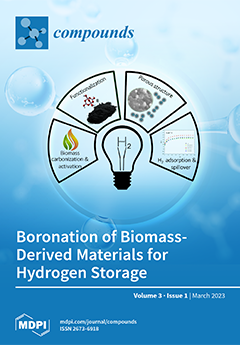Coordination compounds of Co(II), Cu(II), Y(III), Zr(IV) and La(III) ions were synthesized from the
N-salicylidene aniline (
L) derived from the condensation of aniline with salicylaldhyde and 1,10-phenanthroline (
phen) as a secondary mixed ligand.
L,
phen and their
[...] Read more.
Coordination compounds of Co(II), Cu(II), Y(III), Zr(IV) and La(III) ions were synthesized from the
N-salicylidene aniline (
L) derived from the condensation of aniline with salicylaldhyde and 1,10-phenanthroline (
phen) as a secondary mixed ligand.
L,
phen and their complexes were characterized using various physiochemical methods, such as elemental analyses (CHN), Fourier-transform infrared spectroscopy (FT-IR), molar conductance (Λ), magnetic susceptibility (μeff), proton nuclear magnetic resonance (
1H NMR), ultraviolet–visible spectroscopy (UV–Vis) and thermogravimetric analysis (TG/DTG). The analytical and spectroscopic data supporting the chemical formulas of the metal complexes and chelation of
L and
phen with the metal ions forming octahedral complexes. FT-IR spectra demonstrated that
L chelated with metal ions as a bidentate ligand via the oxygen atom of the phenolic group with a band in the range 3378–3437 cm
−1 and the nitrogen atom of the azomethine group at 1612 cm
−1. In addition,
phen chelated through two nitrogen atoms in the range 1525–1565 cm
−1. The
1H NMR results confirmed the IR assumption that the ligand connected to the metal ions via the phenolic’s oxygen atom. The molar conductance measurements of the complexes revealed high values of the electrolytic nature of these complexes in the range of 90.40–125.80 S cm
2 mol
−1. Thermal analysis (TG/DTG) was used to differentiate between coordinated and hydrated water molecules and the thermal stability of the complexes. Finally, the anti-microbial activities of the complexes were investigated against fungi (
Candida albicans), Gram-negative bacteria (
Escherichia coli and
Salmonella typhimurium) and Gram-positive bacteria (
Staphylococcus aureus and
Micrococcus sp.) using the disc diffusion method. The La(III) complex was significant against
C. albicans compared with all other compounds and reference standard control.
Full article




